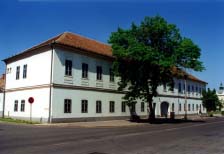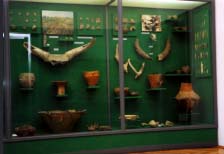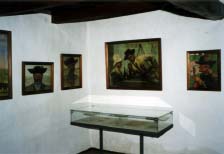THE MUSEUM HAJDÚSÁGI
The museum of our town

The former residence of Hajdú District is placed on the southern side of the Bocskai square. The building is one of the most important architectural monuments of this region (Alföld), it's the oldest secular public building of the county. It was built between 1762 and 1871 in three phases. The third phase was connected to the square-arrangement.
After Hajdú District was terminated (1876) the building was used for different services. Nowadays it is the seat of the Museum Hajdúsági and the Court of Justice of the Town.
Already in the second half of the 19th century there was an ethnographic, archeological and historic collection-work in our town. The collection was made by teachers and students. In order to establish the financial sources a Museum Foundation was called into being. In Hungary the process focused on bringing the town-museums into existence was supported by Flóris Rómer, who was a historian of art and the member of the Hungarian Scientic Academy (MTA).

The Town-Museum was founded in 1924 in Hajdúböszörmény. Péter H. Fekete, the director of Dezső Baltazár Protestant Civic School played an important role in it. With his persistent work, researches and studies he contributed to the establishing of the museum in our town. At that time the ethnographic, archeological and historic collections, that were based on the work of the collecting groups, formed the best part of the material in the museum.
A few years later, in 1928 the the local authority decided about the support of the institution. They provided a permanent place, annual budget and an appointed director. The organized research could begin this way.
The institution adopted the name Museum Hajdúság in 1951. The first permanent exhibition was opened at that time and showed the history and ethnography of the hajdús. Between 1966 and 1985 a new exhibition-material was displayed which supplemented the earlier collections with recent results of research.
The current permanent exhibition, the third, is based on the researches of the last period. Not long ago the building was subjected to a complete reconstruction obtaining its monumental character. Thereby the residence of the Hajdú District can make again the visitors welcome in its original glory. The exhibition can be seen on the second floor, in fourteen exhibition-rooms. There is a statue-park in the yard that was established in the middle of the 1980s. Another exhibition-room can be found in the building of the museum, it's called Litkey-gallery.
The Miklós Káplár Memorial House

The building was the home of painter Miklós Káplár. In 1978 the City Hall has opened a memorial museum in the house. It was built in 1853 and bears the marks of the folk architecture of Hajdúböszörmény. Káplár was an authentic illustrator of the worldfamous Alföld (Great Hungarian Plain), people of Alföld and herdsmen's life.
There are about 40 pictures and a collection of various objects as a part of his legacy can be seen in the memorial house.


The
Museum of
Ethnography
Art-gallery

Collection
from the History
of War